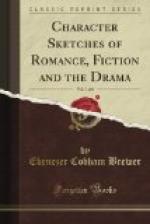DEERFIELD. The particulars of the captivity of the Williams family of Deerfield, (Mass.), are told by John Williams, the head of the household. The Indians entered the town before dawn Feb. 29, 1703, broke into the house, murdered two children and a servant and carried the rest into the wilderness. Mrs. Williams being weak from a recent illness, was killed on the journey.—John Williams, The Redeemed Captive Returning to Zion (1707).
DEFARGE (Mons.), keeper of a wine shop in the Faubourg St. Antoine, in Paris. He is a bull-necked, good-humored, but implacable-looking man.
Mde. Defarge, his wife, a dangerous woman, with great force of character; everlastingly knitting.
Mde. Defarge had a watchful eye that seldom seemed to look at anything.—C. Dickens, A Tale of Two Cities, i. 5 (1859).
DEFENDER OF THE FAITH, the title first given to Henry VIII, by Pope Leo X., for a volume against Luther, in defence of pardons, the papacy, and the seven sacraments. The original volume is in the Vatican, and contains this inscription in the king’s handwriting; Anglorum rex Henricus, Leoni X. mittit hoc opus et fidei testem et amicitiae; whereupon the pope (in the twelfth year of his reign) conferred upon Henry, by bull, the title “Fidei Defensor,” and commanded all Christians so to address him. The original bull was preserved by Sir Robert Cotton, and is signed by the pope, four bishop-cardinals, fifteen priest-cardinals, and eight deacon-cardinals. A complete copy of the bull, with its seals and signatures, may be seen in Selden’s Titles of Honor, v. 53-57 (1672).
DEFOE writes The History of the Plague of London as if he had been a personal spectator, but he was only three years old at the the time (1663-1731).
DEGGIAL, antichrist. The Mohammedan writers say he has but one eye and one eyebrow, and on his forehead is written CAFER ("infidel”)
Chilled with terror, we concluded that the Deggial, with his exterminating angels, had sent forth their plagues on the earth.—W. Beckford, Vathek (1784).
DEIRD’RI, an ancient Irish story similar to the Dar-Thula of Ossian. Conor, king of Ulster, puts to death by treachery the three sons of Usnach. This leads to the desolating war against Ulster, which terminates in the total destruction of Eman. This is one of the three tragic stories of the Irish, which are: (1) The death of the children of Touran (regarding Tuatha de Danans); (2) the death of the children of Lear or Lir, turned into swans by Aoife; (3) the death of the children of Usnach (a “Milesian” story).
DEK’ABRIST, a Decembrist, from Dekaber, the Russian for December. It denotes those persons who suffered death or captivity for the part they took in the military conspiracy which broke out in St. Petersburg in December, 1825, on the accession of Czar Nicholas to the throne.




